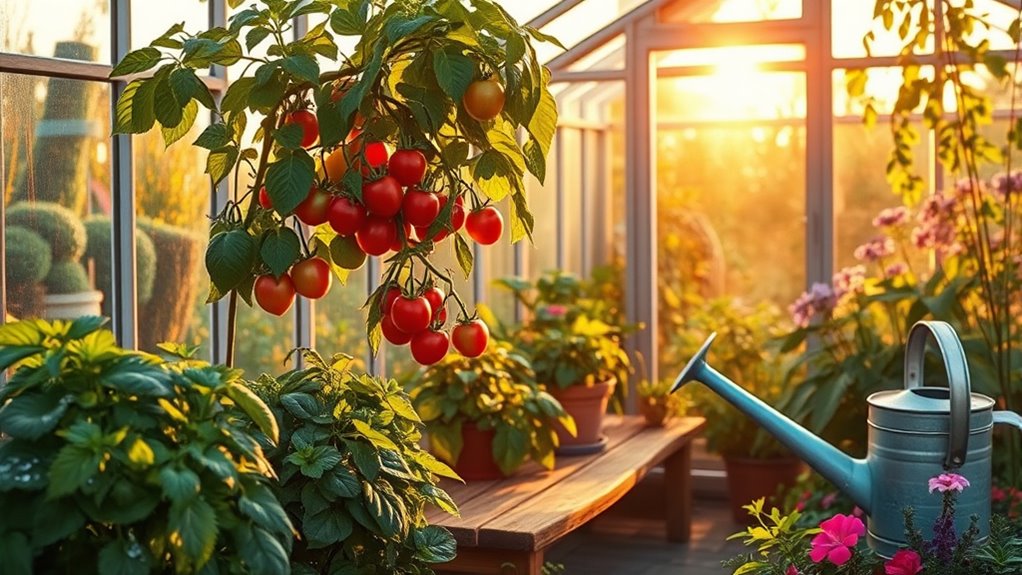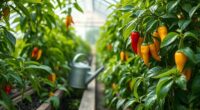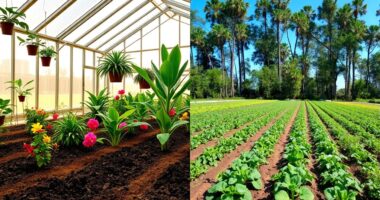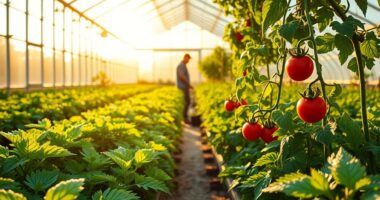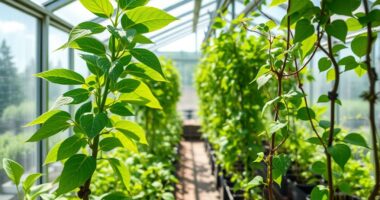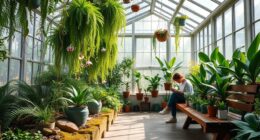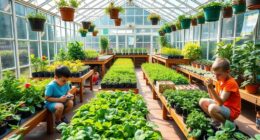A backyard greenhouse lets you enjoy an extended growing season, allowing fresh produce to thrive in early spring and late fall. You can control the environment, which keeps plants healthy by managing temperature and humidity. Plus, it protects crops from harsh weather and pests, saving you on chemicals. It’s also space-efficient, maximizing your gardening area. Not only does gardening promote physical and mental well-being, but it can also reduce your grocery bills. Want to discover more advantages?
Key Takeaways
- A backyard greenhouse extends the growing season by up to 60%, allowing for early spring and late fall harvests.
- It provides a controlled environment that optimizes temperature, humidity, and light for optimal plant growth.
- Greenhouses protect crops from extreme weather, pests, and diseases, reducing the need for chemical treatments.
- Space-efficient techniques like vertical growing and hydroponics maximize productivity while minimizing costs.
- Gardening in a greenhouse promotes physical and mental well-being while improving air quality and conserving water.
Extended Growing Season
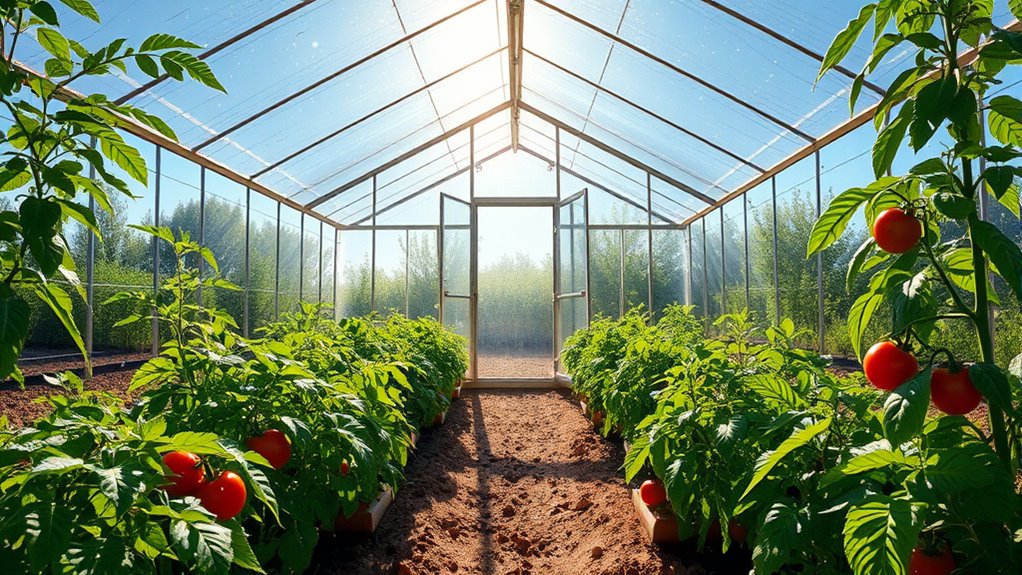
While many gardeners face limitations due to seasonal changes, a backyard greenhouse can greatly extend your growing season. With this setup, you can enjoy up to 60% longer growing periods compared to traditional outdoor gardening.
Imagine harvesting fresh produce in early spring and late fall, all thanks to the protective environment a greenhouse provides. You’ll experience increased crop yields and improved quality, allowing you to cultivate a diverse array of plants that wouldn’t thrive outside.
Techniques like hoop houses or cold frames can also help, but nothing compares to the benefits of a dedicated greenhouse. By adapting to your climate, you’ll make the most of your garden, ensuring year-round planting and harvesting. Additionally, a well-designed greenhouse can help you maximize your garden’s potential, providing the ideal conditions for your plants to thrive.
Controlled Environment
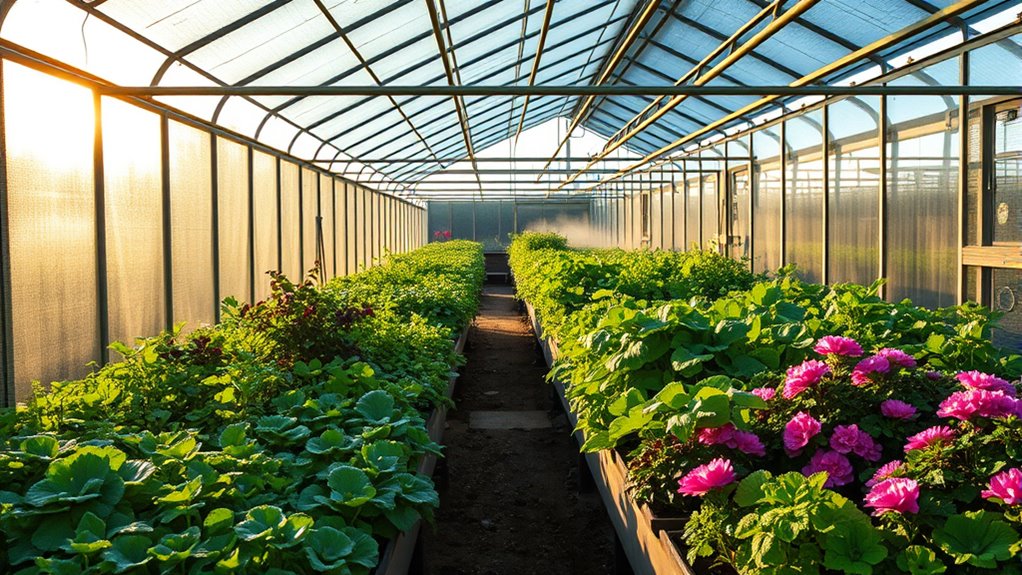
A backyard greenhouse creates a controlled environment that optimizes plant growth by managing key factors like temperature, humidity, and light.
You can easily maintain the ideal temperature for your plants, preventing the stress that extreme weather can cause. With proper humidity management, you’ll reduce the risk of diseases while promoting healthy development.
Easily maintain ideal temperatures and humidity for your plants, promoting health and reducing disease risk.
You can also control light exposure with shading or supplemental lighting, ensuring your plants get the right amount. Implementing ventilation systems enhances air circulation, fostering a healthy atmosphere.
Plus, automation options can help streamline these processes, making care easier. In this stable environment, your plants will thrive, leading to faster growth, higher yields, and diverse crop options, all year round.
Protection From Elements
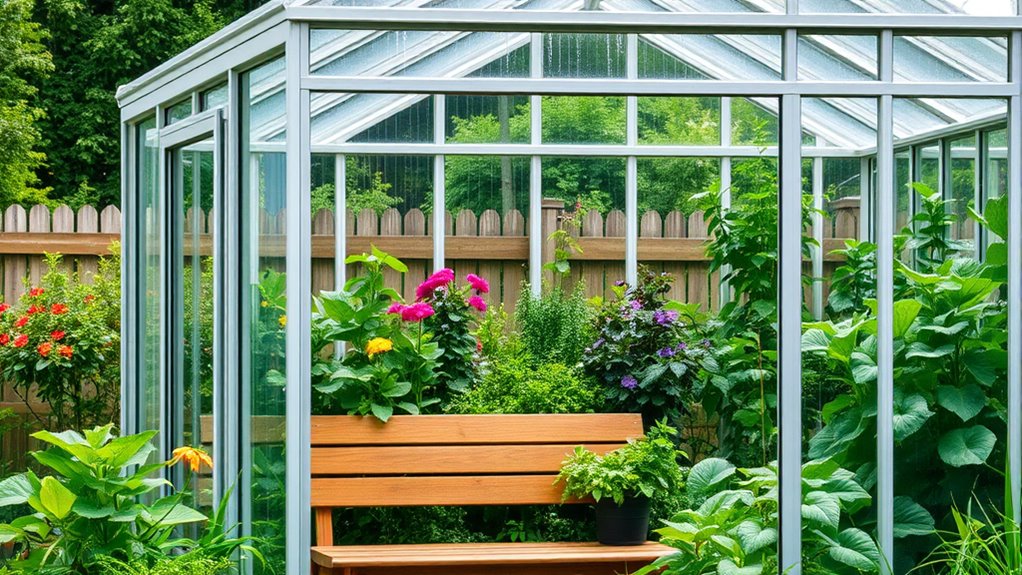
In addition to creating a controlled environment for ideal plant growth, a backyard greenhouse offers robust protection from various elements that can threaten your plants.
It regulates temperature, shielding your crops from extreme heat and cold. Wind damage is minimized, keeping soil moist and plant structures intact. Excessive rainfall is managed, preventing soil erosion and root rot, while frost protection allows for year-round cultivation.
The greenhouse also filters excessive sunlight, preventing overheating. Beyond weather, it acts as a barrier against pests and diseases, reducing the need for chemicals. This isolation promotes healthier plant development, enabling you to monitor potential outbreaks effectively.
Space and Cost Efficiency
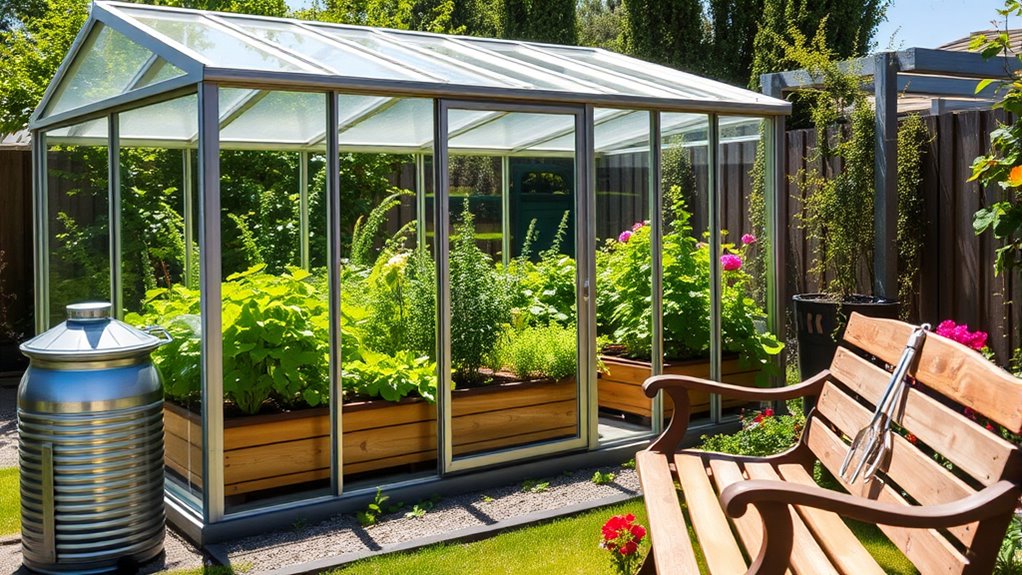
By maximizing available space and minimizing costs, a backyard greenhouse can greatly enhance your gardening experience. You can utilize vertical growing methods like shelving and trellises to increase your planting area markedly.
Choosing compact plants or implementing hydroponics boosts productivity while saving space. Additionally, movable benches can double your growing area, allowing for more plants in a smaller footprint.
Cost efficiency is another major benefit. With year-round production, you reduce seasonal costs and enjoy more harvests.
Greenhouses also lower water bills by minimizing evaporation and cut pesticide expenses by controlling pests and diseases. Plus, growing your own produce decreases grocery bills, making your gardening venture not only productive but economically smart as well. Implementing these techniques can enhance your personal and community resilience during food shortages.
Health and Environmental Benefits

Transforming your backyard into a greenhouse offers numerous health and environmental benefits.
You’ll engage in physical activities like bending and lifting, boosting your strength and flexibility. Nurturing plants can greatly reduce stress and anxiety, promoting mental well-being. Plus, the greenery purifies the air, improving air quality and reducing respiratory risks.
Spending time in your greenhouse also stimulates vitamin D production, essential for your bones and immune system. Additionally, having a greenhouse allows you to experience growing your own food, which can enhance your connection to nature and foster a sense of accomplishment.
Spending time in your greenhouse boosts vitamin D production, vital for strong bones and a healthy immune system.
Environmentally, greenhouses conserve water through efficient irrigation and shield plants from extreme weather, enhancing crop protection. By growing your food locally, you cut down on transportation-related carbon emissions.
Versatility and Accessibility
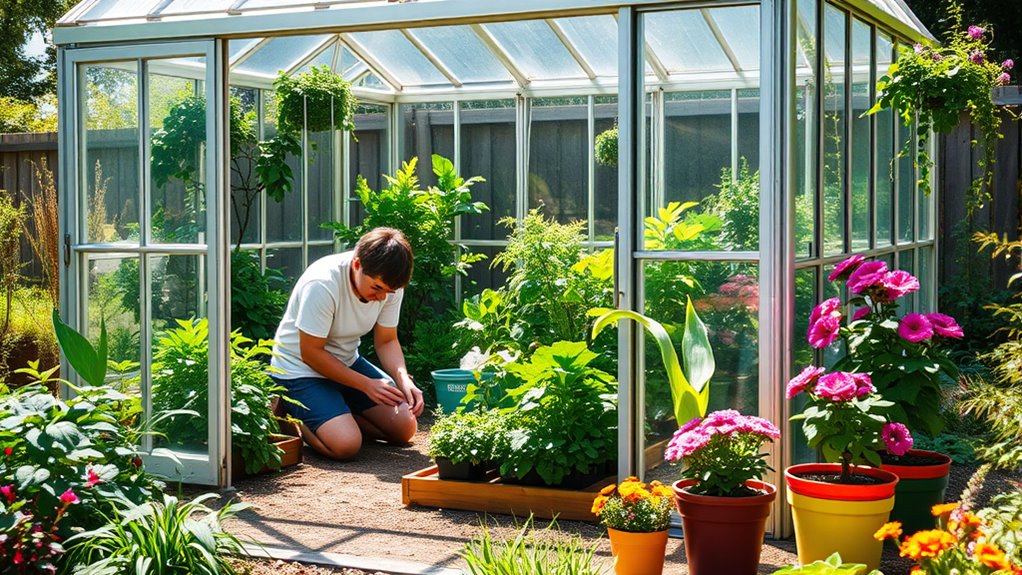
When you think about a backyard greenhouse, its versatility really shines through.
You can grow a variety of plants, even those that need special conditions, while also finding space-saving solutions tailored to your yard.
Plus, with DIY projects, you can customize your greenhouse to fit your gardening style and needs.
Diverse Plant Options
A backyard greenhouse opens up a world of diverse plant options, making gardening more versatile and accessible than ever.
With the ability to grow year-round, you can cultivate everything from tomatoes and peppers to unique tropical plants, regardless of your local climate. The controlled environment guarantees ideal conditions for sensitive plants, protecting them from pests and diseases while minimizing chemical use.
Plus, you can start seeds early for a head start on the growing season. Whether you’re a beginner or an experienced gardener, modern greenhouse designs make it easy to experiment with various crops, including herbs, flowers, and even microgreens, enriching your gardening experience and expanding your harvest potential.
Space-Saving Solutions
With the ability to grow a wide variety of plants, a backyard greenhouse not only enhances your gardening experience but also presents exciting opportunities for space-saving solutions.
By utilizing vertical growing techniques, like hydroponic towers and hanging pots, you can maximize your planting area. Raised beds allow roots to thrive while keeping soil warm and weed-free.
Installing shelving gives you a place to grow more plants and organize tools efficiently. You can also use temporary furniture for flexible workspace.
Modular designs and customizable accessories let you adapt layouts to suit your needs, while strategic plant placement and multi-level planting guarantee peak sunlight exposure.
These solutions make your greenhouse both versatile and accessible, maximizing every inch of your space.
DIY Greenhouse Projects
Building your own greenhouse can be an exciting way to enhance your gardening experience while enjoying the flexibility of customization.
With DIY projects, you can save money by selecting affordable, locally sourced materials that fit your budget. Tailor the design to your specific needs, incorporating features like rainwater harvesting or solar-powered ventilation.
Plus, you’ll develop valuable skills in carpentry and horticulture as you build. This hands-on approach not only fosters a sense of accomplishment but also allows for creative expression.
By integrating eco-friendly materials, you contribute to sustainability while minimizing waste.
Ultimately, your DIY greenhouse becomes a unique reflection of your gardening passion and a space that evolves with your growing expertise.
Year-Round Harvests
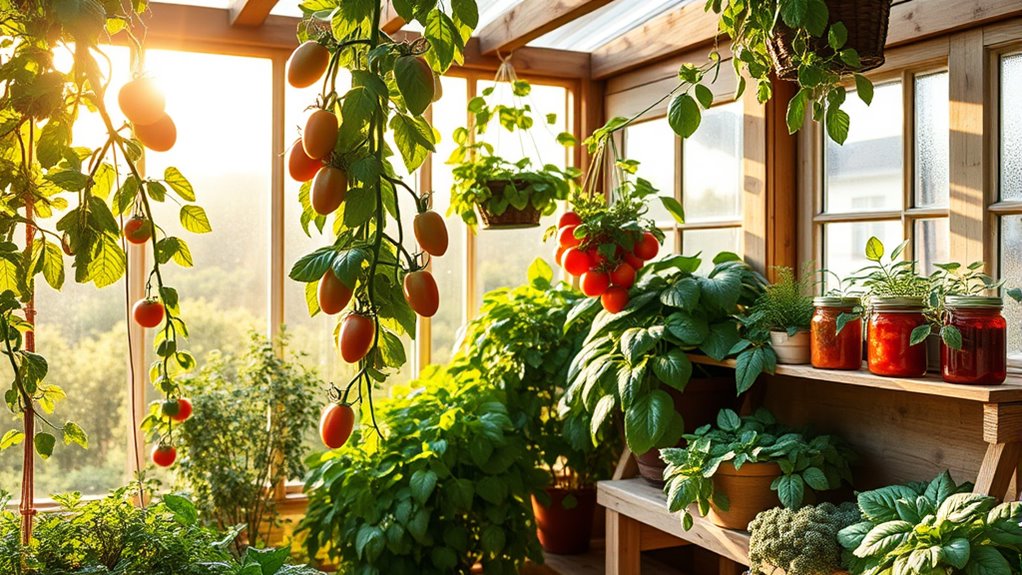
While many gardeners are limited by seasonal changes, having a backyard greenhouse allows you to enjoy year-round harvests.
You can extend your growing season well beyond typical weather limits, thanks to the climate control that a greenhouse provides. With the ability to regulate temperature, humidity, and light, you can create ideal conditions for a diverse range of crops.
This means you’ll have a consistent supply of fresh produce, from fruits and vegetables to herbs, regardless of the season. Plus, plants are protected from harsh weather, resulting in higher quality harvests.
Whether you’re experimenting with new varieties or simply enjoying uninterrupted gardening, a greenhouse makes year-round gardening not just possible, but productive and fulfilling.
Frequently Asked Questions
What Materials Are Best for Building a Greenhouse?
When you’re building a greenhouse, consider materials like multiwall polycarbonate for its durability and insulation.
Glass looks great and lets in lots of light, but it can be expensive and fragile.
Fiberglass is strong but yellows over time.
For a budget-friendly option, plastic sheeting works well for seasonal use.
For the frame, cedar’s rot resistance and aluminum purlins are great choices that guarantee your structure lasts and performs effectively.
How Much Sunlight Does a Greenhouse Need?
Imagine a sun-drenched sanctuary, where plants unfurl like dreams, reaching for radiant light.
Your greenhouse needs ample sunlight to flourish—ideally 12 to 16 hours during the growing season. Full sun plants crave at least 6-8 hours daily, while others thrive with 4-6 hours.
Adjust your strategies with seasons; supplemental lighting can bridge gaps in winter. Keep an eye on light intensity and duration to nurture your green companions effectively.
Can I Use a Greenhouse for Hydroponics?
Yes, you can definitely use a greenhouse for hydroponics!
In fact, it creates an ideal environment for growing plants without soil. You’ll enjoy consistent temperatures and protection from pests, while maximizing your space.
Just guarantee you have the right setup for air circulation and humidity control.
With careful management, you’ll experience faster growth rates and healthier plants, making your hydroponic greenhouse a rewarding venture for year-round production.
How Do I Maintain Optimal Humidity Levels?
To maintain ideal humidity levels in your greenhouse, regularly monitor with a hygrometer. Aim for 40-80% humidity, adjusting as needed.
You can increase humidity using cool mist humidifiers or by misting and watering plants. To reduce it, ventilate by opening doors and using exhaust fans.
Keep an eye on your watering habits and guarantee good air circulation to distribute moisture evenly. Balancing these factors will help your plants thrive.
What Are the Common Pests in Greenhouses?
In a thriving greenhouse, pests lurk like shadows, threatening your plants’ health. Common pests you’ll encounter include aphids, which distort leaves, and whiteflies, notorious for spreading viruses.
On the flip side, beneficial insects can help control these nuisances. Fungus gnats may tempt moisture, while mealybugs cling to stems.
Regular scouting and preventive measures are essential to maintain a healthy environment, ensuring your plants flourish despite these unwelcome guests.
Conclusion
As you step into your backyard greenhouse, you can almost feel the warmth of the sun on your skin, even in the chill of winter. The vibrant greens of fresh herbs and vegetables surround you, a reflection of your dedication and care. With each harvest, you’re not just enjoying fresh produce; you’re nurturing your health and the environment. It’s amazing how a small structure can transform your gardening experience, bringing year-round joy and abundance right outside your door.
